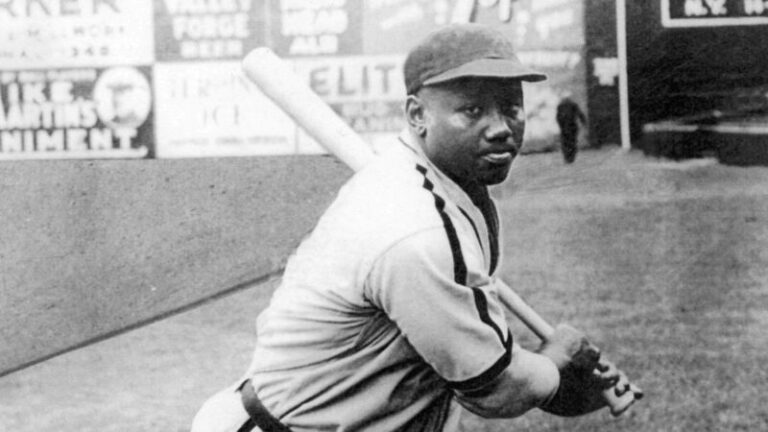CNN
—
Major League Baseball has incorporated the statistics of former Negro league players into the historical records on its website, meaning legendary leaders in some categories, such as Babe Ruth and Ty Cobb, have been replaced in the record books by players who were not allowed to play on the same fields as them during segregation.
Josh Gibson, one of the greatest sluggers in Negro League history, became the best batting average in MLB history with a career batting average of .372, surpassing Ty Cobb’s .367.
According to the MLB website, Gibson also surpassed Babe Ruth in career slugging percentage.
“We are proud to now include Negro League players in the official historical record. This effort is focused on ensuring that the statistics and milestones of all those who contributed to the development of the Negro Leagues are available to future generations of fans,” MLB Commissioner Rob Manfred said in a statement.
“Their on-field accomplishments will serve as a gateway to learning more about this triumph in American history and the path that led to Jackie Robinson’s Dodgers debut in 1947.”
Mark Rucker/Transcendental Graphics/Getty Images
Josh Gibson slides safely into home plate during the 1944 Negro League East-West All-Star Game at Comiskey Park in Chicago.
Gibson was inducted into the Baseball Hall of Fame in 1972.
“We’re excited,” Sean Gibson, the slugger’s great-grandson, told CNN. “This is a long time coming, not just for Josh Gibson but for the whole rest of the great Negro Leagues family.”
The power-hitting catcher’s Baseball Hall of Fame plaque (he is one of 35 Negro League stars enshrined in Cooperstown) notes that he “hit nearly 800 home runs in the League and independent leagues” during his 17-year playing career.
But the vast majority of those home runs came not in league-sanctioned games (about 50 to 75 per season) but in exhibition games against former major leaguers or white semi-pro teams.
“This is truly an exciting day. It’s been a long time coming,” Negro Leagues Baseball Museum Director Bob Kendrick said at a news conference Wednesday. “This is truly a landmark moment in the history of black baseball and the Negro Leagues.”
Kendrick continued: “You can’t reduce the story of the Negro Leagues to statistics. Absolutely not.”
“This story is much bigger than just statistics. This story is bigger than the game of baseball in many ways.”
Kendrick also addressed baseball fans who may be upset that their favorite players have fallen in some of the rankings.
“That doesn’t make them any less valuable,” Kendrick said, “it just gives you an opportunity to learn about some of the names you should have known by now.”
More than 2,300 Negro League players from 1920 to 1948 have been added to the MLB database, but additional statistics are “still being discovered.”
Additionally, Hall of Famers such as Jackie Robinson, Satchel Paige and Minnie Minoso began to have their MLB career statistics reflected by their Negro League achievements.
For example, Robinson had 49 hits with the Kansas City Monarchs in 1945, increasing his career hit total from 1,518 to 1,567, Paige’s win total increased from 28 to 125, and Miñoso had 150 hits with the New York Cubans, eclipsing the 2,000-hit milestone with 2,113.
This came about three and a half years after MLB recognized the Negro Leagues as its equal leagues and compiled statistics and records for the thousands of black players who played in the Negro Leagues from 1920 until the late 1940s.
The certification occurred in December 2020, but MLB said at the time it needed time to consider how the certification would affect MLB records, in part because some statistics were still being compiled and because MLB needed to distinguish between league-sanctioned games and exhibition games.
“The Negro Leagues’ abbreviated schedule, with its revenue-generating exhibition games, was the product of MLB’s exclusionary practices,” MLB historian John Thorne, who served as chairman of the Negro Leagues Statistical Research Committee, said in a statement. “It would be a double punishment to deprive the best black players of their rightful place among the greatest players of all time.”
Baseball historian and committee member Larry Lester added, “The story of the Negro Leagues has always been about stories, legends and exaggerated truths. Those stories have always been entertaining, but now our conversation has been quantified and we’re qualified to support the true pinnacle of these athletes.”
“All fans should welcome this statistical reparation towards social reparations.”
Mark Rucker/Transcendental Graphics/Getty Images
The Negro League Newark Eagles pose for a team portrait at their home stadium, Rupert Stadium, in 1939. Monte Irvin is in the back row, far left, and Mule Suttles is in the back row, center.
MLB said in 2020 it was “righting a long-standing wrong” by improving the status of the Negro Leagues, which consisted of seven leagues and about 3,400 black and Latino players from 1920 to 1948.
“Many people know the names Martin Dihigo, Josh Gibson and Satchel Paige, but what about the thousands of players who played in the Negro Leagues from 1920 to 1948 who are finally starting to be recognized as players at the major league level,” Scott Shimkus, one of the researchers credited by MLB for compiling and building the Seamheads Negro Leagues Database, said at the time.
“Their statistical records, their careers, will be considered on par with anyone who played in the National League or American League during that time.”
“It’s sad that this great history has been hidden from them,” Lester, co-founder of the Negro Leagues Baseball Museum in Kansas City, said at the time.
Bob Kendrick, president of the Negro Leagues Baseball Museum, said the award is “a historic recognition of the men and women who were cut from major league baseball, had the vision and courage to create their own league and helped change the game of baseball and the country.”

